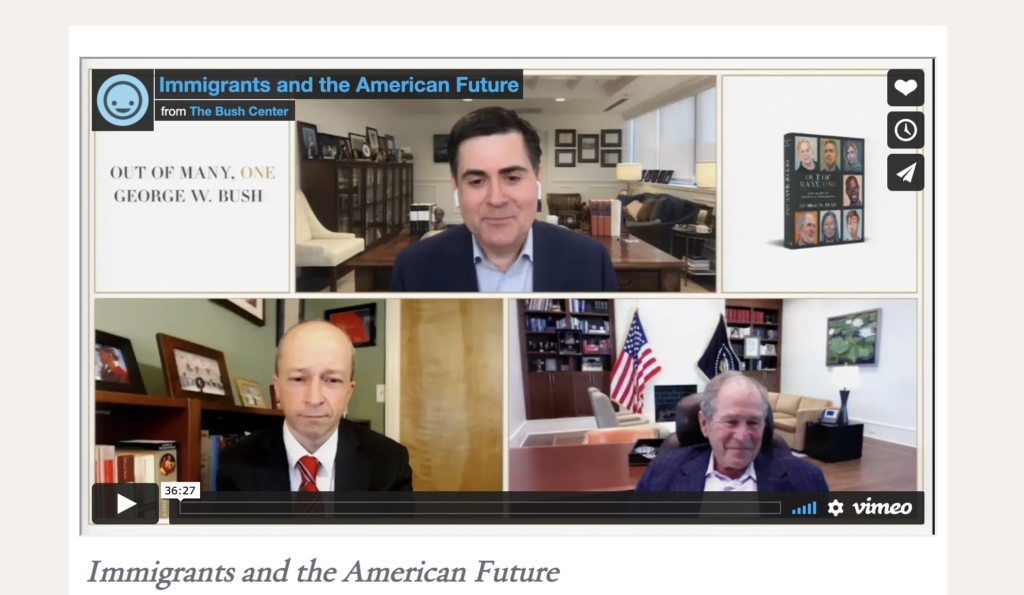
NASHVILLE (BP) – Viewing human beings with “a loving eye” offers a helpful philosophy in addressing the United States’ “fractured” immigration system, former President George W. Bush said in an online conversation cosponsored Thursday (May 6) by the Southern Baptist Ethics & Religious Liberty Commission.
The ERLC joined with the George W. Bush Institute and the National Immigration Forum to present the 35-minute virtual event. ERLC President Russell Moore conducted the discussion with Bush and conservative scholar Yuval Levin. The publication of Bush’s latest book – “Out of Many, One: Portraits of America’s Immigrants” – prompted much of the conversation.
Bush told Moore his philosophy on immigration begins with “all life is precious, and we’re all God’s children. If that’s how you view immigration, then you don’t view people with [a] hostile eye. You view them with a loving eye.”
“And loving eye doesn’t mean tearing down a border wall,” he said. “Loving eye means treating people with respect.”
Moore asked Bush, who served as president from 2001 to 2009, how to change survey results that show some religious communities “are actually becoming less supportive of immigrants and refugees when that used to be the reverse.”
The former president said in response, “Are our churches too political? Are they focused on the right mission, which is saving souls? . . . Until there is a religious awakening to a certain extent, a revival of mission, this issue may not be as important as it used to be.”
Despite the multi-decade failure to approve federal reform of the immigration system, Bush said progress can be accomplished, “but it’s going to have to be in bite-sized pieces. It can’t be the overall deal.”
Bush said “the place to start” on immigration reform is finding a solution for the category of undocumented immigrants known as Dreamers, who were brought to the United States as children.
Nearly three-fourths of Americans support granting legal status to undocumented immigrants brought across the border as children, according to a 2020 survey by the Pew Research Center. Why then, Moore asked, hasn’t a federal solution for Dreamers been enacted?
Bush said he guesses it is because politics “now reigns supreme,” adding that both sides of the political aisle include people who say, “Let’s keep this issue alive because it benefits us politically.”
In February, a congressional bill designed to enable Dreamers to earn permanent legal status and, ultimately, citizenship by meeting specific requirements gained reintroduction, 20 years after it was first offered.
The ERLC has supported for several years a permanent, legislative solution for this category of undocumented immigrants, and Moore commended the proposal’s reintroduction.
Levin – director of social, cultural and constitutional studies at the American Enterprise Institute – agreed immigration reform cannot be an all-or-nothing effort.
“[U]ltimately, you have to begin from where you can find some agreement rather than begin from the edges, where people can yell at each other or, worse yet, yell about each other without ever really engaging with each other at all,” said Levin, who served on the White House domestic policy staff under Bush, as well as executive director of the President’s Council on Bioethics.
Part of what Bush tried to do in office and what some are trying to do now, Levin said, “is see that there’s room for taking steps, for making compromises on one issue and then another. … The border can be safe, while we’re also making room for people who want to build lives here, for people who need to escape despotism and danger in other places. We can be our best selves, and we can also take care of the concerns that people have around this issue.”
When asked how Americans can be helped to overcome the fear some have of immigrants changing the country, Bush said, “It takes leadership for starters. It takes leaders being willing to stand up and make the case of why one shouldn’t fear but one should welcome.
“It is a very hot political issue, and once an issue becomes politically hot, it’s very difficult to paint a positive picture that rises above the noise.”
Bush’s new book – which consists of his paintings of 43 immigrants and stories about them – is an attempt to present such a picture, he said.
Levin, an immigrant from Israel as a child and one of Bush’s subjects in the book, said, “Every immigrant is a face, is a story, is a human being who contributes something to who we are.”
Bush said he campaigned on immigration reform in 2000 and 2004, “and nothing got done.”
“But nevertheless, it was an important issue to highlight,” he said. “And nothing’s been done since.”
Yet, Bush said he is “upbeat about the country. I think we can get some things done on this issue. I really do.”
In April, a bipartisan group of congressional members – Sens. John Cornyn, R-Texas, and Kyrsten Sinema, D-Ariz., and Reps. Henry Cuellar, D-Texas, and Tony Gonzales, R-Texas – introduced the Bipartisan Border Solutions Act to address the surge of migrants – especially unaccompanied children – at the border with Mexico. The proposal includes the creation of four processing centers to handle such surges and new protections for unaccompanied minors sent to U.S. sponsors.
In an April 30 letter, Moore thanked the bill’s four sponsors for their leadership, which he said proves “border security need not be in conflict with our history and heritage as a welcoming nation for those fleeing persecution.”
Twice since 2011, messengers to the SBC’s annual meeting have approved resolutions on immigration reform that called for securing the border and establishing “a just and compassionate path to legal status,” with restitutionary measures, for undocumented immigrants already in the United States.

















